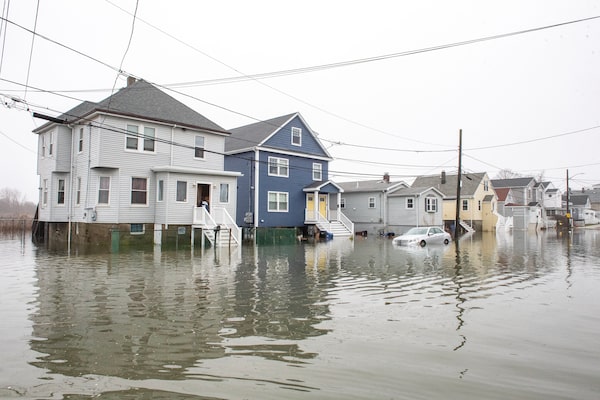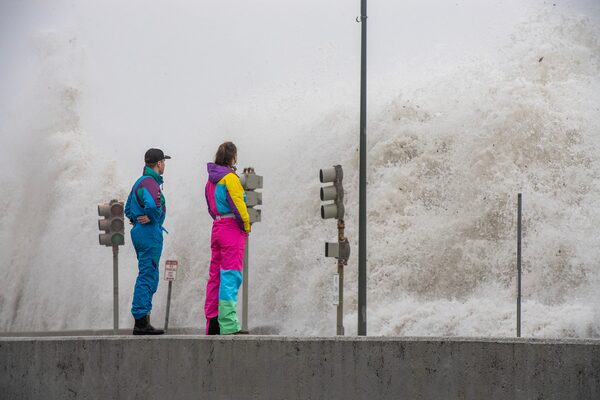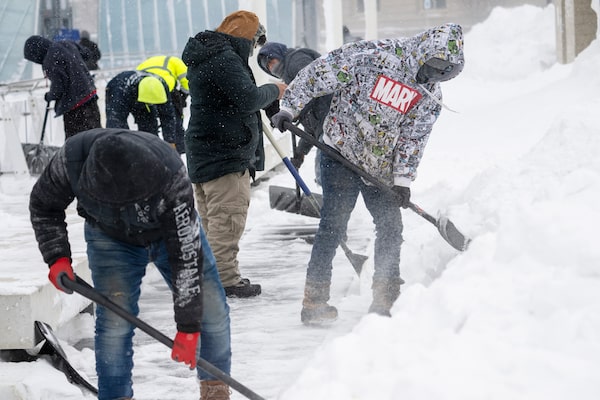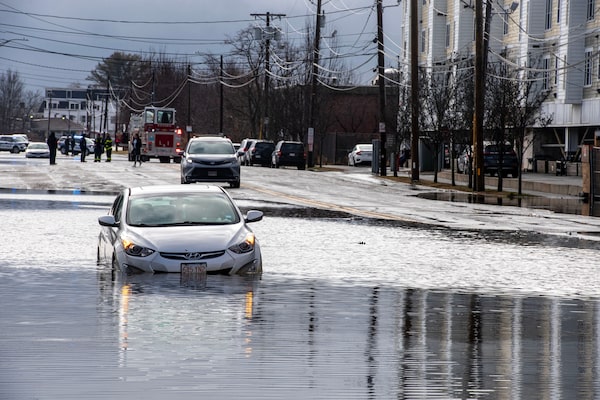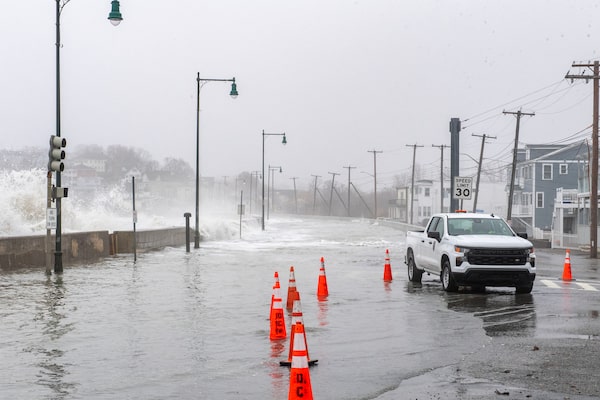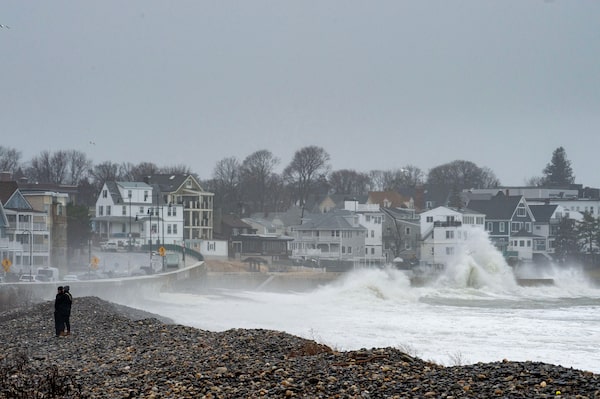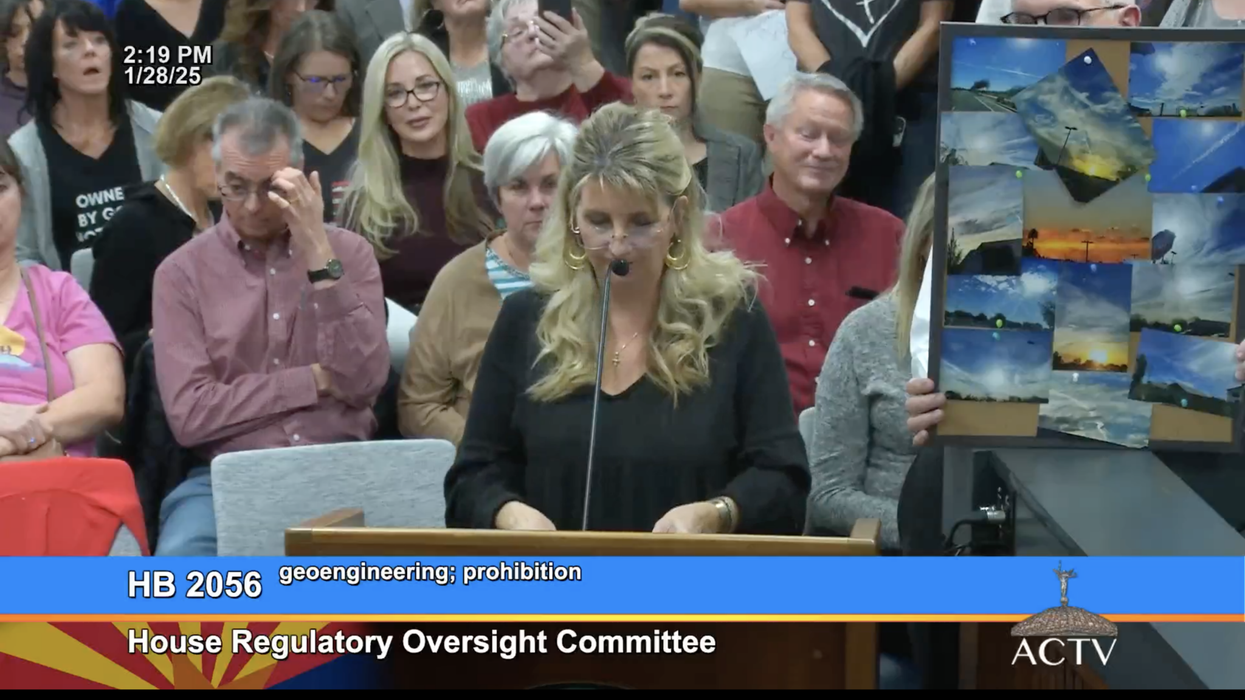
Screenshot via ACTV/azleg.gov
Jodi Brackett speaks to the House Regulatory Oversight Committee on Jan. 28, 2025, alongside pictures of contrails she believes are evidence of “chemtrails” in Arizona.
Jerod Macdonald-Evoy, Arizona MirrorJanuary 29, 2025
Conspiracy theorists came out in force Tuesday afternoon to support a Republican bill that aims to ban “geoengineering,” citing the long debunked “chemtrails” conspiracy theory as evidence that nefarious actors are already turning Arizona’s skies into a laboratory and treating its unsuspecting residents as guinea pigs.
“This started when I noticed lines in the sky that did not look normal,” Jodi Brackett told the House Regulatory Oversight Committee.
As Brackett stood at the podium in the legislative hearing room, a man held a collage of photos of contrails taken in Arizona. Brackett said she brought the issue to freshman GOP legislator Lisa Fink’s attention.
Claims that Arizona has seen an increase in contrails left behind by airliners was a major theme among many of the speakers who came to support the bill.
“Whether you know it or not, your body is part of their laboratory,” Crystal Hansen told the committee claiming that the vapor trails left behind by airliners are “not condensation,” citing a website that has posted altered videos and photos as “evidence” of the conspiracy.
The geography of the Phoenix metropolitan area, where many of those who spoke in favor of Fink’s House Bill 2056 said they reside, plays a role in those long-hanging contrails that many see as “proof” of a larger conspiracy. The region sits basically in a bowl surrounded by mountains, with an inversion above that bowl that traps the air below it. That results in high ozone and other pollutant levels — as well as contrails that linger in the air longer than they do in most other places.
“We, the people, are extremely concerned with all the trails in our skies,” Melissa Price said to the committee, adding that she wants lawmakers to send the bill to the ballot for voters to decide on.
But Price did concede that “even with all the weather modification” she claimed was happening, the state is “not seeing any rain” and remains facing the effects of a historic drought.
Fink’s bill would ban geoengineering in Arizona. In simple terms, geoengineering is the practice of intentionally attempting to modify the atmosphere. In recent years, it has been explored as a possible way to combat the increasingly extreme effects of climate change.
The field is largely theoretical with only small projects taking place, some of which have faced backlash from local communities. Geoengineering has recently become the focus of groups that have previously pushed unfounded conspiracy theories about vaccines.
The National Oceanic and Atmospheric Administration currently monitors the planet’s atmosphere for signs of geoengineering programs by other nations or by small venture capitalist backed groups.
The emerging field has caused fierce debate among scientists, some of whom see it as a way to combat mankind’s impact on the planet, while others see it as another way to create climate chaos.
Many refer to the practice as climate intervention, and some scientists have been studying it as a means of combating climate change. These efforts have included studying things like solar radiation modification, a process that aims to decrease surface temperatures by reflecting sunlight away from the planet.
Last year, Tennessee lawmakers passed a law that banned geoengineering, with lawmakers during debate alluding to the debunked “chemtrails” conspiracy theory. Online conspiracy theorists have long pointed to the condensation left behind by airliners as being part of a larger conspiracy to modify the weather or poison the populace, though no evidence of such programs exist and the contrails planes sometimes leave behind are little more than water vapor that has frozen into ice crystals.
Other speakers also saw the bill as a way to combat other bogus geoengineering conspiracy theories that have long had a place in the fringes of conspiracy culture.
Leslie Forster told the committee that the bill would help protect Arizonans from the High-frequency Active Auroral Research Program, also known as HAARP, which studies the planet’s upper atmosphere. The research project has been accused of causing a litany of weather-related events, despite its inability to impact the weather.
Speakers also confused sulfur iodide with sodium iodide, a chemical commonly used in cloud seeding. Cloud seeding eventually became a focus of the committee, as Fareed Bailey, a lobbyist representing the Salt River Project, said the utility was concerned about the bill’s ban on it.
Fink’s HB2056 bill would ban a litany of geoengineering practices, including cloud seeding, deploying aerosol particles in the stratosphere, releasing chaff into the atmosphere, solar radiation modification or any other attempts to modify the weather. Her legislation is similar to several others filed in other states this year.
Bailey said SRP has been studying cloud seeding as a possible way to help with the state’s water woes, but all research has been theoretical in computer models. SRP has not flown any aircraft to conduct cloud seeding tests, Bailey said.
“We do not want to close the door to this promising technology,” he said, adding that silver iodide, the main chemical used in cloud seeding, has been found to be largely non-toxic. Bailey’s claim was met with boos and jeers from many in the audience.
The bill initially was written to bar any government agency, research project, university, “public or private organization” or “military force” from engaging in geoengineering, with violators facing a $500,000 fine and a felony, with up to three years of prison; the the director of the Department of Water Resources would have been tasked with investigating any claim of geoengineering.
But the GOP-led committee amended the proposal to remove those penalties and the responsibility of the head of the water agency, instead allow citizens to bring any geoengineering claims to court, where they’d be awarded injunctive relief if they proved their case. The amendment also adds a ban on universities funding any research into solar radiation modification.
One attendee felt the amendment lacked “teeth” and suggested that the punishment for geoengineering be treason — which is punishable by death — eliciting cheers from the attendees.
Others asked members of the committee to “get on Instagram” to see the evidence of geoengineering that is allegedly happening out of Sky Harbor International Airport. Many cited increased issues with asthma as proof of the geoengineering plot.
With the increase in population and heat, the Phoenix metro area has seen a marked increase in the number of high pollution days, which leads to more adverse reactions to those with asthma and other breathing complications.
Some in attendance also appeared to believe in other conspiracy theories, sporting t-shirts supporting election reforms based on election fraud falsities and sharing with the committee their belief that a large number of children are being sex trafficked, a core component of the QAnon conspiracy theory. Local election conspiracy theorist Gail Golec also came out to support the bill Tuesday afternoon.
The formal GOP platform makes no mention of climate change, greenhouse gases, the environment, pollution, clean air or clean water. It makes a brief mention of conservation in a section on restoring “American Beauty.” And although there is broad scientific consensus that human activity is causing climate change, and that its effects are becoming more extreme, Arizona Republicans largely reject that it is happening at all.
Last year, state Senate Republicans backed a bill to bar state government and universities from spending money to reduce greenhouse gases or research climate change, deeming them both “Marxist” ideas that are “anti-God.”
Democratic committee members voiced concern that they did not hear from any experts, such as physicians or scientists. When the minority lawmakers said they didn’t see evidence of what the bill’s proponents were saying, many in attendance booed, leading Republican Committee Chair Joseph Chaplik to threaten bringing in security if outbursts continued.
Rep. Rachel Keshel, R-Tucson, who is married to conspiracy theorist Seth Keshel, said she has seen “adequate research” that the alleged chemicals involved in the fictional geoengineering leads to increased Azlhiemers.
And Chaplik said his inability to see individual airplanes flying more than 20,000 feet above Phoenix that are leaving contrails in the sky was concerning enough to support changing Arizona law to ban geoengineering.
“You’re seeing these in the sky at nighttime or early morning, you’re really not seeing the planes fully flying around the air,” he said, adding that he has been talking with Fink about the issue for “a few months.”
The bill passed out of the committee along party lines, with Republicans voting in favor and Democrats opposing. The bill heads next to the full House of Representatives for consideration.
Arizona Mirror is part of States Newsroom, a nonprofit news network supported by grants and a coalition of donors as a 501c(3) public charity. Arizona Mirror maintains editorial independence. Contact Editor Jim Small for questions: info@azmirror.com










